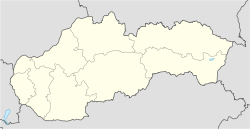|
Podhorany, Kežmarok District
Podhorany [pɔdɦɔrani] (German: Maltern, Hungarian: Maldur, Rusyn: Подгорані) (German pronunciation: [maltɛʁn] Hungarian pronunciation: [mɒldur]) is a village and municipality in KežmarokDistrict in the Prešov Region of north Slovakia.[5] HistoryIn historical records the village was first mentioned in 1235. In 1910 the village had 598 mainly German inhabitants of Lutheran confession.[6] It was part of the German language island of the Oberzips. Before the establishment of independent Czechoslovakia in 1918, Podhorany was part of Szepes County within the Kingdom of Hungary. From 1939 to 1945, it was part of the Slovak Republic. On 26 January 1945, the Red Army dislodged the Wehrmacht from Podhorany and it was once again part of Czechoslovakia. After the end of World War II the German population was expelled, according to the Beneš decrees.[7] GeographyThe municipality lies at an altitude of 598 metres and covers an area of 11.02 km2. It has a population of about 2300 people. DemographicsAccording to 2010 census total population had been 2333. In the village is sizeable Roma nationality, which had been claimed by 949 inhabitants, which is ca. 41% of the total population. In 2010 there had been 1165 males and 1166 females, what is ca. 50% for both. In 2019, they constituted an estimated 78% of the municipality's population.[8] Economy and infrastructureIn the village is foodstuff store, train stop, elementary school and a pub. Cultural sightseeings are gothic Roman Catholic and classical evangelical churches. References
External links |
||||||||||||||||||||||||||||||||||||||||
